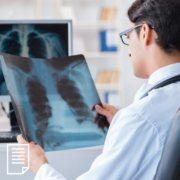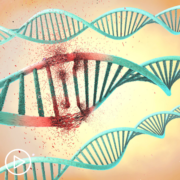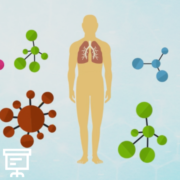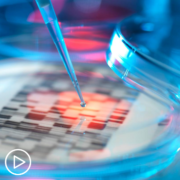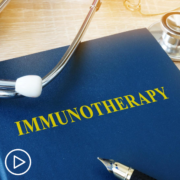Lung Cancer Treatment Decisions: What’s Right for You?
Lung Cancer Treatment Decisions: What’s Right for You? from Patient Empowerment Network on Vimeo.
When choosing an lung cancer treatment, what should be considered? Dr. Jessica Bauman, a lung cancer specialist, reviews treatment types and key decision-making factors, including how test results influence options and provides advice to help you advocate for better care.
Dr. Jessica Bauman is assistant professor in the department of hematology/oncology and as associate program director of the hematology/oncology fellowship training program at Fox Chase Cancer Center in Philadelphia. Learn more about Dr. Bauman here.
Download Program Resource Guide
See More From the The Pro-Active Lung Cancer Patient Toolkit
Related Programs:

Lung Cancer Treatment Advances: What are Antibody Drug Conjugates? |
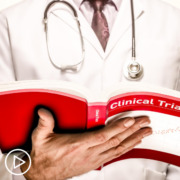
Why You Should Consider a Clinical Trial for Lung Cancer Treatment |

|
Transcript:
Katherine:
Hello and welcome. I’m Katherine Banwell, your host for today’s program. Today we’ll discuss how you can be proactive in your lung cancer care to partner with your healthcare team to make the best care and treatment decisions for you. Joining us today is Dr. Jessica Bauman. Welcome, Dr. Bauman. Would you please introduce yourself?
Dr. Bauman:
Absolutely, thank you so much for inviting me here today. My name is Jessica Bauman, and I am a thoracic and head and neck oncologist at Fox Chase Cancer Center.
Here I am also the associate program director for our hematology/oncology fellowship program as well as one of the disease site leaders of one of our research teams.
Katherine:
Excellent, thank you. A reminder that this program is not a substitute for seeking medical advice. Please refer to your healthcare team about what might be best for you.
Dr. Bauman, from my understanding, there are two main types of lung cancer – small cell lung cancer and non-small cell lung cancer. Would you provide a brief overview of how these two types of lung cancer differ?
Dr. Bauman:
Absolutely. So, I think it’s important for any new patient who’s coming in, to see me or any medical provider. The first thing we need to establish when we are thinking about a lung cancer diagnosis is what the cells look like under the microscope. And the simplest way to think about this is either they look like small cell lung cancer, or they look like non-small cell lung cancer.
And that really can decide what kind of treatment we need to pursue. For small cell lung cancer – small cell lung cancer can be a more aggressive lung cancer that certainly can spread throughout the body and requires more urgent treatment in general when we’re thinking about the speed in which we need to start to treat patients for this cancer. For non-small cell lung cancer, in general, we don’t have to start treatment as quickly as we need to for small cell. And there is a lot more information right now that we need other than just the simple non-small cell lung cancer diagnosis. We need to know whether it is adenocarcinoma or squamous cell carcinoma, which are further subdivided.
And then we often need even more information about those subtypes to be able to decide ultimately what the best treatment plan is.
Overall, I would say about 15% of lung cancers are small cell. So, they’re more rare. And about 80% to 85% of lung cancers are non-small cell. And the most frequent kind of non-small cell lung cancer right now is adenocarcinoma. It didn’t used to be that way. Squamous cell carcinoma actually used to be more common, but in more recent years, adenocarcinoma is becoming more common. And interestingly, it’s also becoming more common in women.
Katherine:
Why is it becoming more common?
Dr. Bauman:
So, part of that is we think that the demographics are changing somewhat in terms of lung cancers. So, the traditional risk factor, of course, of lung cancer is smoking, however, not all patients who have lung cancer were smokers. And we are seeing, in fact, more people being diagnosed with lung cancer who have never smoked or, in fact, are light smokers. And so, we think that that is likely playing a role.
Katherine:
Before we move into testing and staging, are there any common misconceptions you hear when you see new lung cancer patients for the first time?
Dr. Bauman:
Sometimes I see people think, “Oh, lung cancer is a death sentence.” I certainly see people say that. But I think that one of the wonderful parts about being a lung cancer oncologist right now is our treatment options have really been revolutionized in the last 10 to 20 years. And we have more options right now, and we have a better understanding of this cancer, then we ever have had.
And so, I do think that I look with more optimism at this diagnosis, obviously, which is still quite devasting to patients and their families.
Katherine:
Right. Dr. Bauman, what testing should take place following a lung cancer diagnosis?
Dr. Bauman:
So, this very much depends on how the cancer was diagnosed initially. So, some cancers are diagnosed on screening – lung cancer CTs right now – but other cancers are found incidentally, for other reasons. Or there are some that are diagnosed with a scan because somebody’s developing a symptom. So, in general, what I would say is that we always need good imaging essentially of the entire body when a lung cancer is suspected. Often this includes CAT scans, but this very commonly also includes a PET scan. And it will often include a brain MRI as well because the best way to the look at the brain is with an MRI.
Obviously, that can vary a little bit depending on what studies people have already had and what radiologic techniques are most accessible.
Katherine:
What about molecular testing and biopsies?
Dr. Bauman:
So, sorry, I was sort of going on the imaging. But so, of course, you need full imaging. But the first thing you need to do that is paramount is establishing a histologic diagnosis, which goes to this initial thought of, “Is this small cell? Is this non-small cell? What is it?” So, if there is a lung mass that is suspected to be lung cancer, the first thing that happens is a biopsy as well as imaging. The imaging helps us establish, “Has this gone anywhere else? Does it involve the lymph nodes?” and helps us with the initial staging workup. Often there is a biopsy of the mass itself.
But there are often biopsies as well as the lymph nodes that are involved, in particular in the center of the chest called the mediastinum, because that also helps us establish the stage of the cancer.
And then if the cancer does look to have spread to somewhere else, we sometimes biopsy only that area or that area in addition to establish that it, in fact, has spread to a different place such as the liver or the bone. Once that biopsy is done, and once we know what type of lung cancer it is, then we also send more studies on the biopsy itself that help us determine what the best treatments are, in particular when we’re talking about what I call “systemic treatments.”
So, treatments that are going into the body and all over the body that involved immune therapies, chemotherapies, or targeted therapies. So, that extra testing that we do is something that’s called molecular testing.
It’s also called next generation sequencing. There are a bunch of different terminology that we use.
Katherine:
Okay. Dr. Bauman, would you walk us through how lung cancer is staged? And is it different for small cell vs. non-small cell lung cancer?
Dr. Bauman:
Absolutely. So, as we talked about, the first thing that we do is we do get a biopsy to establish the diagnosis. The second piece is often if it looks to be a cancer that is only limited to the chest – so there is a mass and maybe some activities in lymph nodes that we’re concerned about but nowhere else – not only do we want to biopsy the mass itself, but we also want to know whether those lymph nodes are involved. So, those are biopsied because that will tell us the stage of the cancer. Staging very much depends on the size of the tumor itself, and then it also depends on, “Has it spread to lymph nodes in the center of the chest, and has it spread outside of the chest to other places?”
And so, early-stage lung cancers are just the primary cancer itself that has not spread anywhere else. More advanced stage lung cancers – things like Stage IIs and Stage III lung cancers – are ones that also involve the lymph nodes. And then a Stage IV lung cancer involves a lung cancer that has spread to somewhere outside of the body. And depending on the stage is really what determines the way we approach treatment for these patients.
Katherine:
And that is actually my next question. What do the results of these tests tell us about prognosis and treatment choices?
Dr. Bauman:
So, they tell us stage, and, ultimately, prognosis and treatment choices are completely linked to the stage of a cancer. So, an early-stage lung cancer, often a Stage I or Stage II lung cancer, primarily our first choice of treatment is surgery. And if surgery is feasible for the patient – because, of course, it also depends on their other medical comorbidities and whether they can withstand a surgical resection of the cancer.
But usually, early-stage lung cancers we start with surgery. And then depending on what the pathology shows us, we sometimes include a course of chemotherapy afterwards to decrease the risk of the cancer coming back. More advanced lung cancers, so Stage III lung cancers, often involved what we call “multiple modalities.” So, for some patients we do a combination of chemotherapy and radiation in an attempt to cure the cancer. Often that is followed by immunotherapy. There are other patients who have Stage III lung cancer where we do chemotherapy and radiation and follow that with surgery.
So, it’s a very case-dependent decision algorithm, where it really depends on where the tumor is, the type of tumor, what the surgery would be, what the patient’s underlying health status is, etc.
And then if it is a Stage IV cancer, often we are really approaching this with systemic therapies. So, once a cancer has spread outside the lung, we traditionally think of this often as an incurable cancer. And there is a much more limited role of surgery and radiation, though I wouldn’t say that they’re absolutely off the table. Again, we sometimes think of these in sort of a case-by-case scenario. But in general, our approach for a Stage IV cancer is with some kind of systemic therapy. And that completely depends on all those special tests that we do that we were talking about that we send on that initial biopsy.
Katherine:
What about the significance of chromosomal abnormalities?
Dr. Bauman:
So, what I would say is, what we do for, in particular, in the setting of a Stage IV lung cancer diagnosis right now, is we send molecular testing on the biopsy samples of these patients, in particular if they have adenocarcinoma.
And the reason we do this, what this gives us, is it tells us about the DNA of the tumor, and whether there are genes in the tumor that are changed in some way that are affecting the cancer’s ability to grow. And the reason that’s so important, is there are new treatments that really capitalize on those changes in the tumor to be able to stop the cancer from growing. The best example of this is for people who have something called an EGFR mutation.
And there are multiple different kinds of mutations. I call it “alphabet soup” because there are so many different letters and numbers.
But if people have an EGFR mutation that we think is one of the primary reasons they have this cancer growing, there are pills that target that EGFR protein that stop the cancer from growing. But if they don’t have that mutation, then those pills are not gonna do them any good.
And so, that is really where lung cancer treatment and diagnosis has become so personalized based on, of course the person itself, but also the characteristics of their tumor.
Katherine:
How can patients advocate for a precise lung cancer diagnosis, and why is that important?
Dr. Bauman:
So, it’s, of course, important because it changes everything that they would be able to be offered in terms of treatment. And so, I think that it is important to, one, really understand what your lung cancer is. Right? What is the stage? What are the treatment options? And if there are treatment options that are not options for you, why is that? And is that because of special testing that has been done? So, I think it’s always important to ask, “Are there other special tests that I need to have on my tumor or on the biopsy?”
And if patients have questions about what options that they have, I think it’s important for them to understand why some options are theirs, and why other options may not be good options for them, and how their physician is making those decisions. Because I do think the more you understand about this, the better you can advocate for the types of treatments you can access.
Katherine:
Absolutely. We just covered some of this, but when deciding on a treatment approach with a patient, what do you take into account when making the decision?
Dr. Bauman:
So, we take into account all of the things that we’ve been talking about. Of course, the No. 1 most important part is the histology, so what the kind of cancer is. No. 2 is what the stage is. And then No. 3 is the health characteristics of that patient.
Do they have underlying health problems that would impact the types of treatment that we would consider? And then ultimately, what are the goals of the patient? Right? So, of course, we have lots of different options, but it’s going to be important to partner with the patient and their family to understand where they are in their life and what kinds of treatments are feasible and acceptable to them.
Katherine:
What about treatment side effects? Do you take that into consideration?
Dr. Bauman:
Absolutely. So, I always talk about my two primary goals for when I’m treating a patient is 1.) is to help them live as long as they can, and No. 2 is to help them live as well as they can. And I do think it is critical to understand the side effects of our treatments and how that may impact the patient and what their underlying issues are. So, for example, if I have a patient who comes to me who already has significant neuropathy because of a prior diagnosis of some kind, we need to strongly consider the types of treatments we’re using to consider one that doesn’t cause neuropathy.
Right? And often there are different treatments that we have where we can really consider the side effects and quality of life for patients in terms of what we have. I’ll also say that treatments and the supportive care that we have to offer have become better over time. So, yes, of course, we give toxic treatments, but we definitely are able to support people better with the side effects that they have to try to minimize those and make it as tolerable as we can.
Katherine:
What do you feel is the patient’s role in this decision, and how does shared decision making come into play?
Dr. Bauman:
So, I think the patient’s role is, of course, this is their body and their lives. Right? I think that it very much is a decision that we make together. And of course, as a lung cancer expert, yes, we’re gonna talk about what we recommend as what we think is, sort of, the gold standard treatment.
But you can’t make anybody do anything. Right? You want people to be their own advocate in terms of their health. And so, I need to know how someone is feeling. I need to know if they’re having significant side effects from treatment. And so, I think the more they can tell me, the more they can ask questions, the more they can understand their illness, the better we can partner to be able to face it together.
Katherine:
Dr. Bauman, now that we’ve discussed factors that go into the treatment choice, would you walk us through the currently available lung cancer treatment approaches and who they might be right for?
Dr. Bauman:
So, we talked about this a little bit, but I would say, so, certainly, the different types of lung cancer treatment depends on the stage of the cancer.
But in general, I’m thinking about the broad categories that we have. So, number 1 being surgery. So, surgery is absolutely one of the most important aspects of lung cancer treatment that we have and is one of the ways in which it is possible to cure lung cancer. So, surgery can happen both as an open surgery, but there are also more minimally invasive surgeries now that have also revolutionized the way they can do surgery in lung cancer. And so, that absolutely plays a very significant role in the treatment of lung cancer.
The second broad approach that I would say is that of radiation. So, radiation also plays a very critical role in lung cancer, often more in advanced-stage disease for patients who have, for example, Stage III disease, where the treatment that we consider is a combination of chemotherapy and radiation also with curative intent.
So, the idea behind this is that it’s cancer that is still in the chest, but it has spread to the lymph nodes in the chest, and a combination of chemotherapy and radiation may still be able to cure patients of this cancer. And so, radiation also can play a critical role. And interestingly, in small cell – which we’ve spoken a little bit less about – radiation and chemotherapy play a very important role in small cell, and often surgery plays less of a roll in small cell. And so, our treatment approach using radiation is in both of these kinds of cancers, and often we’re doing a full course of radiation also in an attempt to cure the cancer for the patient.
The last, sort of, broad category of treatment that I would say is what I call “systemic treatments.” So, that is targeted treatment. That is chemotherapy. And that is immune therapy.
And what we use of those three types of treatments completely depends on the patient’s stage and more information about that patient’s tumor, in particular, the molecular testing as well as what we say is called PD-L1, which is a marker on the tumor that tells me about the responsiveness to immunotherapy.
Often, we use a combination of many of these treatments. So, there are patients who get surgery and then chemotherapy. There are patients who get chemotherapy and radiation and then surgery. And there are patients who get only what we call systemic therapies.
I will also say it’s important to note that for radiation, although there’s a proportion of people that we use radiation with curative intent for a long period of time – so, a six-week course of radiation – we also use radiation to help with symptom management if someone’s having a specific problem that’s causing them a symptom where radiation may help.
The classic example of that is pain. So, if they have a spot in the bone that is causing them a lot of pain, a short course of radiation to shrink that tumor where that is, can be very helpful. And so, radiation we can also use to help with palliation of symptoms. The other things that I’m not getting into significantly today, but are also there, are there are other types of procedures that have become more common where you can go in, for example, with an interventional radiologist and do an ablation of a tumor.
Our interventional pulmonologists also do significant amount of ability to access the lungs and the lymph nodes to be able to help with diagnosis, but they can also do something like a debulking procedure where they can get rid of some of the cancer to stop it from bleeding.
They can also stent open the cancer to help people breathe better. So, there are multiple different other team members who also are really critical to our patient’s care.
Katherine:
Yeah. How do clinical trials fit into the treatment plan?
Dr. Bauman:
So, clinical trials are very important in all of our decision making. So, there are many different kinds of clinical trials, but clinical trials are where we are offering the newest potential treatment options for patients. And there are some clinical trials where it’s a brand-new drug that’s never been in a person before, but there are also clinical trials of drugs that we use from a different disease that has been effective, and now it has good evidence, potentially, in lung cancer, and so it’s being used in lung cancer. There are also trials of new combinations of treatments.
So, for example, one of the most recent, sort of, classic treatment-changing trials was a large trial where everybody who had chemotherapy and radiation for Stage III lung cancer, then received a year of immune therapy vs. not receiving immune therapy to see if that new treatment would help them live longer or would prolong their survival.
And in fact, that trial was very positive, and so it changed the way we treat Stage III lung cancer. So, again, these are just examples of types of clinical trials. But clinical trials are where we are finding out what may be the next best treatments for patients.
And so, when I’m thinking about a treatment approach to a patient, I’m incorporating all of the things that we talked about, but I’m also then thinking about, “Are there clinical trials that may also be relevant to them for their specific situation?” whether that is a clinical trial that involves surgery in some way, or whether that’s a clinical trial that involves a new drug, whether it’s a clinical trial that’s offering a new kind of supportive care.
So, there are lots of different kinds of clinical trials that may be relevant to patients.
Katherine:
Are there emerging approaches for treating lung cancer that patients should know about?
Dr. Bauman:
So, absolutely. I think that there are so many clinical trials that are going on right now for all sorts of different lung cancers.
I think one of the amazing parts about lung cancer right now is how, as I said before, how personalized it has become, and how each individual, depending all of the different factors we talked about, what treatments are best for them. But it also depends on there also may be clinical trials that are specific for that person. And so, for example, if you have a new diagnosis of Stage IV cancer, and you have an EGFR mutation or an ALK mutation, you want to know about clinical trials that are specific to that population because for you, those are what are most relevant for you.
If you have a new diagnosis of a Stage III lung cancer, then you wanna know, “What are the clinical trial options for patients who have Stage III lung cancer?” And so, there are many clinical trials that are asking, sort of, the next best question of, “How can we improve the current standard of care?” And often there really are trials in each of these different areas. So, it’s not just a one-size-fits-all.
Katherine:
Some patients can be fearful when it comes to clinical trials. What would you say to someone who might be hesitant in participating in one?
Dr. Bauman:
So, I very much understand that. I think any kind of treatment can be a scary thing. But I think, as I said before, I think the more that you can understand about your cancer and understand about the science and the research, it helps you then understand where the trial fits in terms of your treatment options.
I think that if you understand what to expect from the treatment that you’re getting, and then what the plan B and plan C could look like, I think that piece of it is also important. And you know, I think that one of the hardest parts about lung cancer right now is even though we have all of these new promising therapies and multiple new approved drugs, with a diagnosis of Stage IV lung cancer, most of the time the cancer learns to grow. And so, even though we have treatments that work really well, there will be a time for most people where the cancer starts to grow, and we need to think about, “Well, why is the cancer growing?”
And often, that is the setting where clinical trials are very relevant because clinical trials are often thinking about just that, “Well, why is the cancer becoming resistant? What is different about the cancer now? And is there some change that would make it relevant for you to do one specific trial over another specific trial?”
Katherine:
Well, and that leads us to treatment monitoring. Once a patient has started treatment, how do you know if it’s working?
Dr. Bauman:
So, we do regular imaging. So, once you have a diagnosis of lung cancer, a CAT scanner will become your friend. In general, depending on what stage of lung cancer you have, you will have a bunch of imaging up front, and then once a treatment plan is put into place, after that treatment has either been completed or started, you will be monitored, in general, regularly for the lung cancer diagnosis. Now, after surgery, that will be for more for surveillance to make sure that the lung cancer doesn’t come back. But if it is more in the setting of a Stage IV lung cancer, then the imaging really helps us determine, “Is the treatment working or not?”
And so, after we start a treatment, usually anywhere between six and eight weeks, we repeat imaging to see, “Is this working? Is it smaller? Is it the same? Has it grown?”
And based on that imaging, and based on how the patient is doing with the treatment, we then decide, “Do we continue this treatment, or do we need to change to a new treatment?” And so, we regularly monitor the patient’s cancer through regular imaging.
Katherine:
Let’s talk about patient self-advocacy. Patients can sometimes feel like they’re bothering their healthcare team with their comments and questions. But why is it important for patients to speak up when it comes to their symptoms and their side effects?
Dr. Bauman:
So, this, I would say, it’s a partnership. The bottom line is, and if I don’t know that something is going on, I can’t help to solve the problem. And if I don’t know about something, a new symptom that could be, potentially, majorly concerning, patients can also get really sick or even end up in life-threatening situations. And so, ignoring things or just hoping things will go away is not in a patient’s best interest.
I think that it is critical that patients are their own self-advocate. I think that I say that often, and I’ve already said that a couple of times on this, but we don’t know unless we’re hearing from them what’s going on. And so, it is so important for patients to keep us updated if they’re worried about something. Certainly, we see them very frequently, and so they can often tell us at their visits what’s going on. But overall, the in-between time is just as critical because it is often the treatments that we give can cause side effects at any time. And so, it is really important that we know about anything that’s going on and for patients to always give us a call.
I mean, that’s the bottom line is, is that if they’re worried about something, we need to know about it.
Katherine:
What supportive care options are there for patients who may have pain management difficulties or even emotional support? Where do they start?
Dr. Bauman:
So, there are often many different kinds of supportive care for patients. I would say that oncologists, of course, are one layer of supportive care. We do a lot of help with symptom management and often even pain management as well as coping and emotional support. However, there are also other people often within cancer centers that are also available to help. And this includes social workers. It also includes psychologists and psychiatrists.
And then the other thing that I think is really important to mention is that we know for patients who have lung cancer or an advanced lung cancer diagnosis, that integrating a palliative care team – a supportive and palliative care team – early into their diagnosis actually helps them live longer as well as better. They have better quality of life, and they have decreased problems with mood.
And so, we know that supportive care and palliative care, specifically in lung cancer, is particularly helpful for both patients and their caregivers. And so, it’s important for patients to also know that there is a whole team, that I think of as, sort of, an extra layer of support, that can help them with symptom management as well as with coping with the day-to-day of what can be a devastating diagnosis.
Katherine:
Yeah. That’s really great advice. To close, what would you like to leave patients with? Are you hopeful?
Dr. Bauman:
So, I would say I am absolutely hopeful. I think that it is so important to know how many changes have happened in lung cancer in the last decades and how much more research is going on everyday to try to improve the care that we can deliver. And so, it’s a great time to be a lung cancer oncologist.
But we also have so much more work to be done.
Katherine:
Dr. Bauman, thank you so much for joining us today.
Dr. Bauman:
Absolutely, my pleasure.
Katherine:
And thank you to our audience for joining us as well. Please fill out the survey that you’ll receive following the program. It helps us to plan future lung cancer programming. And thank you to all of our partners.
To learn more about lung cancer and to access tools to help you become a more proactive patient, visit PowerfulPatients.org. I’m Katherine Banwell. Thanks for joining us.





